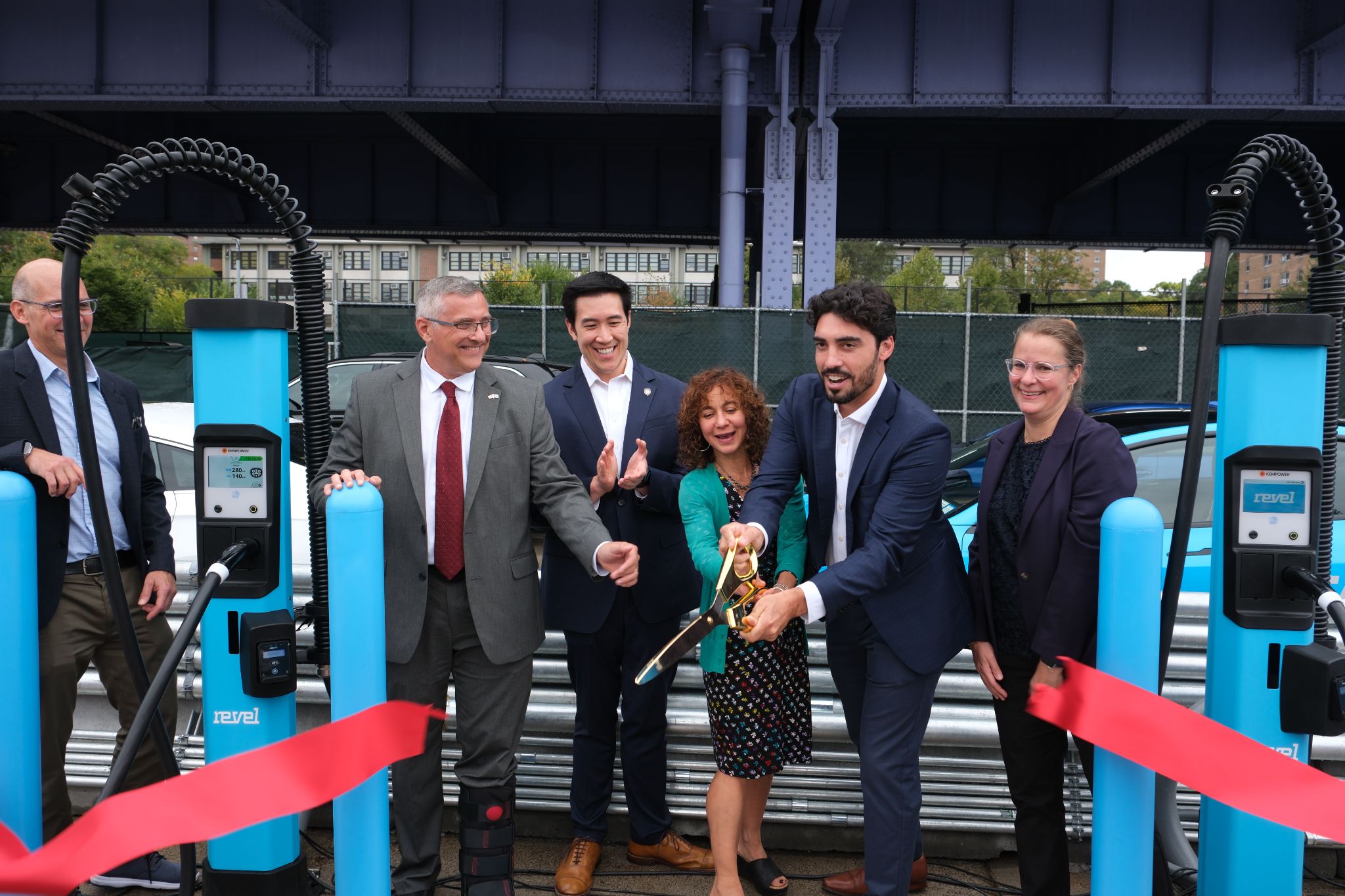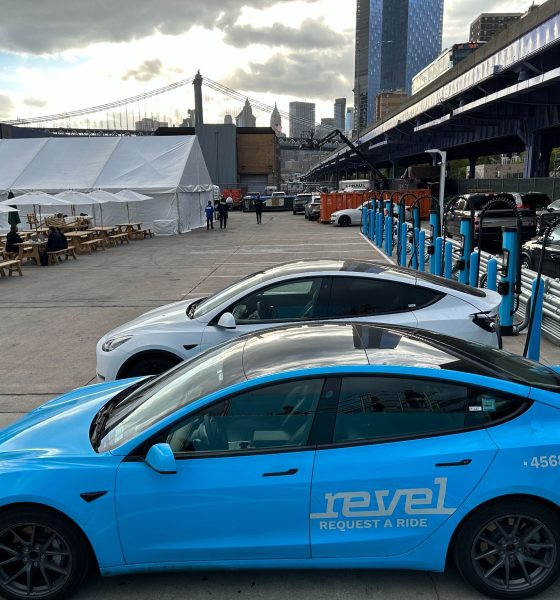Revel has opened its first-ever fast-charging electric vehicle station in Manhattan at Pier 36 on the Lower East Side.
This is the first fully public, 24/7 EV charging station in Manhattan, which has been a major challenge for companies and individuals utilizing EVs due to very limited real estate.
Revel developed the site with New York City’s Economic Development Corporation (NYCEDC). The site features 10 320 kW chargers made by Kempower.
The big challenge with EV ownership when living in New York City is access to public chargers.
While Revel, Tesla, and others are operating charging infrastructure in various boroughs like Queens and Brooklyn, Manhattan is so limited on space that those who utilize EVs for personal use or ride-sharing truly struggle for options.

Frank Reig, Revel’s Co-Founder and CEO, said:
“Hundreds of thousands of rideshare and taxi trips go in and out of Manhattan every day. With our new Pier 36 Charging Station, Revel is bringing the fastest charging on the market directly to those drivers so they can access EVs easier — saving them money and saving us all from breathing in more needless car pollution…This is Revel’s first in the borough, but definitely not our last!”
Revel has had this new station at Pier 36 in the works for some time. Last year, they hinted during an interview with me that they were working on something in Manhattan. It’s finally here.
This station brings Revel’s total network to 64 public fast chargers across the five boroughs of New York City. Their plans are to expand rapidly, hoping to have 300 active chargers by the end of 2025.
The significance of this station being in Manhattan was recognized by several figures:
State Senator Brian Kavanagh:
“The introduction of this first 24/7 public fast charging station in Manhattan represents a pivotal step in our journey toward a zero-emission transportation network. With the busy flow of rideshare and taxi traffic in and out of Manhattan, providing the fastest charging options directly to drivers not only saves them money but also helps us all breathe a little easier by reducing harmful car pollution.”
NYCEDC President and CEO Andrew Kimball:
“The opening of Revel’s first Manhattan charging station will help New York City become an innovator in accelerating low-carbon alternatives in the transportation sector, spark cutting-edge innovation that will unlock solutions for the global climate crisis, and create new economic opportunity for the city.”
Assemblymember Grace Lee:
“By expanding access to high-speed EV chargers in Lower Manhattan, we are not only promoting green technology but also reducing harmful emissions and improving air quality for our community. This is a crucial investment in the health and well-being of Lower Manhattan, and I look forward to continuing to support initiatives that advance our city’s environmental goals.”
Deputy Mayor for Operations Meera Joshi:
“New York is charging ahead! If we want to meaningfully reduce emissions, more cars will need to plug, rather than chug. But modal shifts will only happen once there’s the infrastructure to support it. Along with our 80,000-strong for-hire vehicle fleet’s transition to electric, the first 24/7 charger in Manhattan is a strong indicator of what’s to come. Thanks to Revel, EDC, DOT and all our partners for this Climate Week milestone. In partnership with the private sector, government continues to deliver for New Yorkers.”
Revel’s expanding number of EV fast chargers will support the evergrowing number of drivers utilizing sustainable powertrains for ride-sharing purposes. The New York City Taxi & Limousine Commission issued approximately 10,000 new licenses for electric-for-hire vehicles in October 2023.
This has brought the share of EV trips to over 10 percent of the total rideshare volume, or approximately 1.5 million rides per month.
I’d love to hear from you! If you have any comments, concerns, or questions, please email me at joey@teslarati.com. You can also reach me on Twitter @KlenderJoey, or if you have news tips, you can email us at tips@teslarati.com.

Elon Musk
Starlink passes 9 million active customers just weeks after hitting 8 million
The milestone highlights the accelerating growth of Starlink, which has now been adding over 20,000 new users per day.

SpaceX’s Starlink satellite internet service has continued its rapid global expansion, surpassing 9 million active customers just weeks after crossing the 8 million mark.
The milestone highlights the accelerating growth of Starlink, which has now been adding over 20,000 new users per day.
9 million customers
In a post on X, SpaceX stated that Starlink now serves over 9 million active users across 155 countries, territories, and markets. The company reached 8 million customers in early November, meaning it added roughly 1 million subscribers in under seven weeks, or about 21,275 new users on average per day.
“Starlink is connecting more than 9M active customers with high-speed internet across 155 countries, territories, and many other markets,” Starlink wrote in a post on its official X account. SpaceX President Gwynne Shotwell also celebrated the milestone on X. “A huge thank you to all of our customers and congrats to the Starlink team for such an incredible product,” she wrote.
That growth rate reflects both rising demand for broadband in underserved regions and Starlink’s expanding satellite constellation, which now includes more than 9,000 low-Earth-orbit satellites designed to deliver high-speed, low-latency internet worldwide.
Starlink’s momentum
Starlink’s momentum has been building up. SpaceX reported 4.6 million Starlink customers in December 2024, followed by 7 million by August 2025, and 8 million customers in November. Independent data also suggests Starlink usage is rising sharply, with Cloudflare reporting that global web traffic from Starlink users more than doubled in 2025, as noted in an Insider report.
Starlink’s momentum is increasingly tied to SpaceX’s broader financial outlook. Elon Musk has said the satellite network is “by far” the company’s largest revenue driver, and reports suggest SpaceX may be positioning itself for an initial public offering as soon as next year, with valuations estimated as high as $1.5 trillion. Musk has also suggested in the past that Starlink could have its own IPO in the future.
News
NVIDIA Director of Robotics: Tesla FSD v14 is the first AI to pass the “Physical Turing Test”
After testing FSD v14, Fan stated that his experience with FSD felt magical at first, but it soon started to feel like a routine.

NVIDIA Director of Robotics Jim Fan has praised Tesla’s Full Self-Driving (Supervised) v14 as the first AI to pass what he described as a “Physical Turing Test.”
After testing FSD v14, Fan stated that his experience with FSD felt magical at first, but it soon started to feel like a routine. And just like smartphones today, removing it now would “actively hurt.”
Jim Fan’s hands-on FSD v14 impressions
Fan, a leading researcher in embodied AI who is currently solving Physical AI at NVIDIA and spearheading the company’s Project GR00T initiative, noted that he actually was late to the Tesla game. He was, however, one of the first to try out FSD v14.
“I was very late to own a Tesla but among the earliest to try out FSD v14. It’s perhaps the first time I experience an AI that passes the Physical Turing Test: after a long day at work, you press a button, lay back, and couldn’t tell if a neural net or a human drove you home,” Fan wrote in a post on X.
Fan added: “Despite knowing exactly how robot learning works, I still find it magical watching the steering wheel turn by itself. First it feels surreal, next it becomes routine. Then, like the smartphone, taking it away actively hurts. This is how humanity gets rewired and glued to god-like technologies.”
The Physical Turing Test
The original Turing Test was conceived by Alan Turing in 1950, and it was aimed at determining if a machine could exhibit behavior that is equivalent to or indistinguishable from a human. By focusing on text-based conversations, the original Turing Test set a high bar for natural language processing and machine learning.
This test has been passed by today’s large language models. However, the capability to converse in a humanlike manner is a completely different challenge from performing real-world problem-solving or physical interactions. Thus, Fan introduced the Physical Turing Test, which challenges AI systems to demonstrate intelligence through physical actions.
Based on Fan’s comments, Tesla has demonstrated these intelligent physical actions with FSD v14. Elon Musk agreed with the NVIDIA executive, stating in a post on X that with FSD v14, “you can sense the sentience maturing.” Musk also praised Tesla AI, calling it the best “real-world AI” today.
News
Tesla AI team burns the Christmas midnight oil by releasing FSD v14.2.2.1
The update was released just a day after FSD v14.2.2 started rolling out to customers.

Tesla is burning the midnight oil this Christmas, with the Tesla AI team quietly rolling out Full Self-Driving (Supervised) v14.2.2.1 just a day after FSD v14.2.2 started rolling out to customers.
Tesla owner shares insights on FSD v14.2.2.1
Longtime Tesla owner and FSD tester @BLKMDL3 shared some insights following several drives with FSD v14.2.2.1 in rainy Los Angeles conditions with standing water and faded lane lines. He reported zero steering hesitation or stutter, confident lane changes, and maneuvers executed with precision that evoked the performance of Tesla’s driverless Robotaxis in Austin.
Parking performance impressed, with most spots nailed perfectly, including tight, sharp turns, in single attempts without shaky steering. One minor offset happened only due to another vehicle that was parked over the line, which FSD accommodated by a few extra inches. In rain that typically erases road markings, FSD visualized lanes and turn lines better than humans, positioning itself flawlessly when entering new streets as well.
“Took it up a dark, wet, and twisty canyon road up and down the hill tonight and it went very well as to be expected. Stayed centered in the lane, kept speed well and gives a confidence inspiring steering feel where it handles these curvy roads better than the majority of human drivers,” the Tesla owner wrote in a post on X.
Tesla’s FSD v14.2.2 update
Just a day before FSD v14.2.2.1’s release, Tesla rolled out FSD v14.2.2, which was focused on smoother real-world performance, better obstacle awareness, and precise end-of-trip routing. According to the update’s release notes, FSD v14.2.2 upgrades the vision encoder neural network with higher resolution features, enhancing detection of emergency vehicles, road obstacles, and human gestures.
New Arrival Options also allowed users to select preferred drop-off styles, such as Parking Lot, Street, Driveway, Parking Garage, or Curbside, with the navigation pin automatically adjusting to the ideal spot. Other refinements include pulling over for emergency vehicles, real-time vision-based detours for blocked roads, improved gate and debris handling, and Speed Profiles for customized driving styles.










